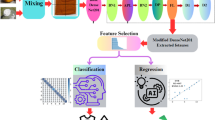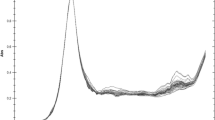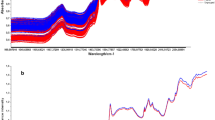Abstract
Detecting adulterants in turmeric is necessary because turmeric is a vital food constituent that adds color and flavor. In this work, the pure turmeric powders were mixed with starch to produce distinct concentrations (0, 10, 20, and 30%) (w/w). The reflectance spectra of samples were taken by visible-NIR spectroscopy. Spectroscopy in the wavelength range 400–1700 nm was used to record reflectance spectra of pure turmeric and starch-contaminated samples. The recorded spectra were preprocessed using a Savitzky–Golay filter and a second derivative with poly order of 2. The preprocessed spectra are then standardized, which are used to train and validate ML models. Three ML models were employed for classification: logistic regression (LR), K-nearest neighbor (KNN), and support vector machines (SVM). The LR and KNN obtained 100% accuracy, precision, recall, and F1-score, while SVM obtained 90% accuracy, 92% precision, 94% recall, and 91% F1-score. The performance of these models was tested with the stratified five fold method. The KNN model obtained the highest average accuracy of 92%, which is excellent compared to the other models.
Access this chapter
Tax calculation will be finalised at checkout
Purchases are for personal use only
Similar content being viewed by others
References
Lanjewar MG, Morajkar PP, Parab J (2022) Detection of tartrazine colored rice flour adulteration in turmeric from multi-spectral images on smartphone using convolutional neural network deployed on PaaS cloud. Multimed Tools Appl 81(12):16537–16562
Akbar A, Kuanar A, Patnaik J, Mishra A, Nayak S (2018) Application of artificial neural network modeling for optimization and prediction of essential oil yield in turmeric (Curcuma longa L.). Comput Electron Agric 148:160–178
Amani M, Kakooei M, Moghimi A, Ghorbanian A, Ranjgar B, Mahdavi S, Davidson A, Fisette T, Rollin P, Brisco B, Mohammadzadeh A (2020) Application of Google earth engine cloud computing platform, sentinel imagery, and neural networks for crop mapping in Canada. Remote Sens 12(21):3561
Ashok V, Agrawal N, Durgbanshi A, Esteve-Romero J, Bose D (2015) A novel micellar chromatographic procedure for the determination of metanil yellow in foodstuffs. Anal Methods 7(21):9324–9330
Fuh M (2002) Determination of sulphonated azo dyes in food by ion-pair liquid chromatography with photodiode array and electrospray mass spectrometry detection. Talanta 56(4):663–671
Shah R (2017) Identification and estimation of non-permitted food colours (metanil yellow and aniline dyes) in turmeric powder by rapid color test and thin layer chromatography. WJPPS 2034–2045
Chen L, Hu J, Zhang W, Zhang J, Guo P, Sun C (2015) Simultaneous determination of nine banned azo dyes in foodstuffs and beverages by high-performance capillary electrophoresis. Food Anal Methods 8(8):1903–1910
Tateo F, Bononi M (2004) Fast determination of Sudan I by HPLC/APCI-MS in hot chilli, spices, and oven-baked foods. J Agric Food Chem 52(4):655–658
Zhao S, Yin J, Zhang J, Ding X, Wu Y, Shao B (2012) Determination of 23 dyes in chili powder and paste by high-performance liquid chromatography-electrospray ionization tandem mass spectrometry. Food Anal Methods 5(5):1018–1026
Parab J, Sequeira M, Lanjewar M, Pinto C, Naik G (2021) Backpropagation neural network-based machine learning model for prediction of blood urea and glucose in CKD patients. IEEE J Transl Eng Health Med 9:1–8
Çetin N, Karaman K, Beyzi E, Sağlam C, Demirel B (2021) Comparative evaluation of some quality characteristics of sunflower oilseeds (Helianthus annuus L.) through machine learning classifiers. Food Anal Methods 14(8):1666–1681
de Macêdo IYL, Machado FB, Ramos GS, Costa AGDC, Batista RD, Filho ARG, Asquieri ER, de Souza AR, de Oliveira AE, Gil EDS (2021) Starch adulteration in turmeric samples through multivariate analysis with infrared spectroscopy. Food Chem 340:127899
Zhong J, Qin X (2016) Rapid quantitative analysis of corn starch adulteration in Konjac Glucomannan by chemometrics-assisted FT-NIR spectroscopy. Food Anal Methods 9(1):61–67
Lohumi S, Lee S, Lee W-H, Kim MS, Mo C, Bae H, Cho B-K (2014) Detection of starch adulteration in onion powder by FT-NIR and FT-IR spectroscopy. J Agric Food Chem 62(38):9246–9251
Xu L, Shi W, Cai C-B, Zhong W, Tu K (2015) Rapid and nondestructive detection of multiple adulterants in kudzu starch by near infrared (NIR) spectroscopy and chemometrics. LWT Food Sci Technol 61(2):590–595
Kar S, Tudu B, Jana A, Bandyopadhyay R (2019) FT-NIR spectroscopy coupled with multivariate analysis for detection of starch adulteration in turmeric powder. Food Addit Contam Part A 36(6):863–875
Ranjan R, Kumar N, Kiranmayee AH, Panchariya PC (2021) Application of handheld NIR spectroscopy for detection of adulteration in turmeric powder. In: 2021 7th international conference on advanced computing and communication systems (ICACCS), pp 1238–1241. https://doi.org/10.1109/ICACCS51430.2021.9441790
Thangavel K, Dhivya K (2019) Determination of curcumin, starch and moisture content in turmeric by Fourier transform near infrared spectroscopy (FT-NIR). Eng Agric Environ Food 12(2). https://doi.org/10.1016/j.eaef.2019.02.003
Zhang Z (2016) Introduction to machine learning: k-nearest neighbors. Ann Transl Med 4(11):218–218
Cortes C, Vapnik V (1995) Support-vector networks. Mach Learn 20(3):273–297
Lanjewar MG, Parate RK, Parab JS (2022) Machine learning approach with data normalization technique for early stage detection of hypothyroidism. In: Artificial intelligence applications for health care
Rashidi HH, Sen S, Palmieri TL, Blackmon T, Wajda J, Tran NK (2020) Early recognition of burn- and trauma-related acute kidney injury: a pilot comparison of machine learning techniques. Sci Rep 10(1):205
Lanjewar MG, Gurav OL (2022) Convolutional neural networks based classifications of soil images. Multimed Tools Appl 81(7):10313–10336
Pramoditha R (2020) k-fold cross-validation explained in plain English. Medium, 20 Dec. https://towardsdatascience.com/k-fold-cross-validation-explained-in-plain-english-659e33c0bc0. Accessed 6 July 2022
Lanjewar MG, Panchbhai KG (2022) Convolutional neural network-based tea leaf disease prediction system on smart phone using PaaS cloud. Neural Comput Appl. https://doi.org/10.1007/s00521-022-07743-y
Parab J, Sequeira M, Lanjewar M, Pinto C, Naik GM (2022) Blood glucose prediction using machine learning on Jetson nanoplatform. In: Handbook of intelligent computing and optimization for sustainable development, pp 835–848
Author information
Authors and Affiliations
Corresponding author
Editor information
Editors and Affiliations
Rights and permissions
Copyright information
© 2023 The Author(s), under exclusive license to Springer Nature Singapore Pte Ltd.
About this paper
Cite this paper
Lanjewar, M.G., Parate, R.K., Wakodikar, R., Parab, J.S. (2023). Detection of Starch in Turmeric Using Machine Learning Methods. In: Kumar, S., Sharma, H., Balachandran, K., Kim, J.H., Bansal, J.C. (eds) Third Congress on Intelligent Systems. CIS 2022. Lecture Notes in Networks and Systems, vol 613. Springer, Singapore. https://doi.org/10.1007/978-981-19-9379-4_10
Download citation
DOI: https://doi.org/10.1007/978-981-19-9379-4_10
Published:
Publisher Name: Springer, Singapore
Print ISBN: 978-981-19-9378-7
Online ISBN: 978-981-19-9379-4
eBook Packages: Intelligent Technologies and RoboticsIntelligent Technologies and Robotics (R0)




